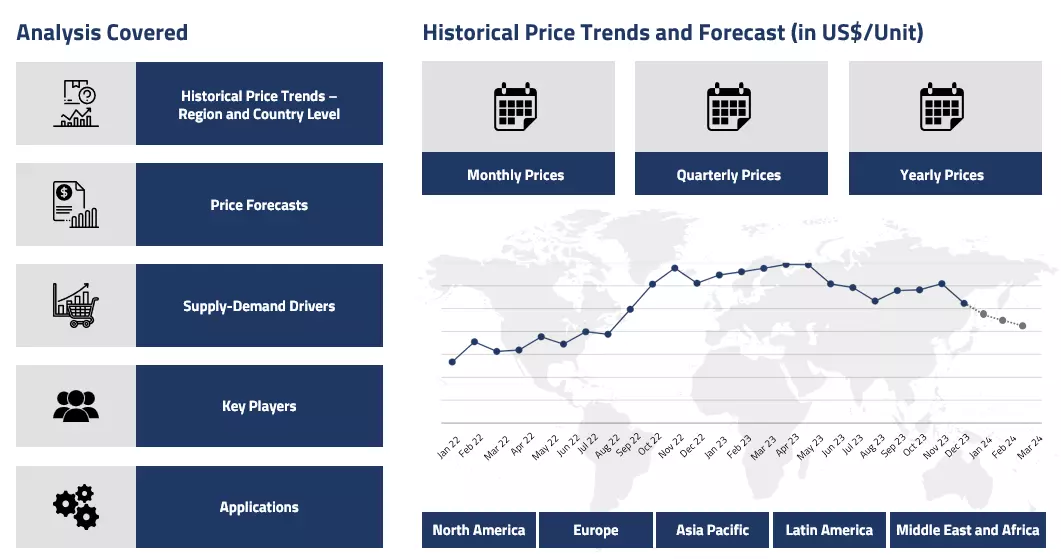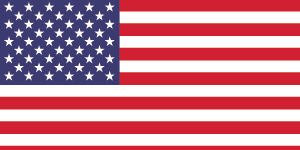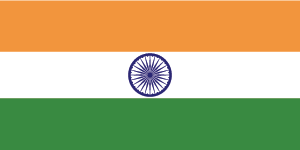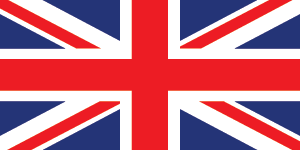Product
Dipropylene Glycol Price Trend and Forecast
Dipropylene Glycol Price Trend and Forecast
Dipropylene Glycol Regional Price Overview
Get the latest insights on price movement and trend analysis of Dipropylene Glycol in different regions across the world (Asia, Europe, North America, Latin America, and the Middle East & Africa).
Dipropylene Glycol Price Trend for the Year 2024
Asia
In Asia, Dipropylene Glycol (DPG) prices showed a mixed pattern throughout 2024. The first quarter began with declining prices due to lower consumption in downstream sectors and currency fluctuations, particularly the weakening of the South Korean won against the US dollar. By Q2, the market stabilized briefly before turning bearish as tepid demand and excessive supply pushed manufacturers in China to lower their quotations.
Dipropylene Glycol Price Chart

Please Login or Subscribe to Access the Dipropylene Glycol Price Chart Data
The third quarter continued this downward trend with range-bound oscillations, influenced by falling upstream propylene prices. Manufacturers faced challenges as buyers adopted a cautious wait-and-see approach, making purchases only when necessary and expecting further price reductions.
Europe
European DPG markets exhibited more volatility in 2024. The year started with an upward price trend driven by geopolitical tensions, logistical disruptions, and constrained inventories. Strong demand from food, healthcare, and pharmaceutical sectors supported this initial price increase. The second quarter saw a deflationary trend as construction activities slowed and the downstream polyol sector weakened. Producers prioritized price stability over profit margins, attempting to reduce older inventories. In the latter half of the year, prices rose despite weak demand, primarily due to rising upstream propylene costs caused by constrained supply and shipping cargo availability.
North America
North American DPG markets experienced steady price increases during the first half of 2024, supported by strong demand from food, pharmaceutical, and healthcare sectors. Growing warehousing demand strained storage capacity, increasing distribution costs that were passed on to consumers.
The second quarter showed relative stability with slight increases as suppliers stocked inventories in anticipation of adverse weather conditions. The third quarter saw oscillating prices, initially positive before declining in September due to softening demand and logistics challenges from seasonal hurricanes, which temporarily disrupted production at some facilities.
Analyst Insight
According to Procurement Resource, DPG prices are expected to continue fluctuating in 2025, with positive support from downstream industries potentially offset by uncertainties in feedstock prices and the crude oil sector.
Dipropylene Glycol Price Trend for the Second Half of 2023
Asia
The prices for dipropylene glycol stayed toward the lower end of the range in the third and fourth quarters of 2023. The compound is an essential component of polyurethane foams, lubricants, and personal care products, and thus, the pricing trajectory of dipropylene glycol was highly dependent on demand from these sectors as well as the dynamics of propylene oxide price.
Therefore, the price of dipropylene glycol decreased during the period, as did the price of raw materials. Further, suppliers were forced to lower prices to promote inventory movement due to excess inventory. The dipropylene glycol prices, however, fluctuated in the northward direction on the advent of the holiday season but soon restored to the previous trajectory when consumer interest in this sector declined.
Europe
In European countries, during the third and fourth quarters of 2023, the dipropylene glycol market followed the patterns observed in Asian countries. The demand for the product remained dull in view of the exaggerated geopolitical challenges. The start of the Israel-Hamas war amid the ongoing Russia-Ukraine crises lowered the rate of exports from European countries, resulting in a robust rise in inventory levels and severely damaging Europe's economy. The period also witnessed fluctuating domestic trade patterns, which led to generally muted market patterns.
North America
Q3 and Q4'23 saw depreciation in the pricing patterns of dipropylene glycol in North America, in accordance with the global trend of the market. The international trading sector of the North American market was disturbed by economic concerns and logistical obstacles, which led to a downward price swing in the dipropylene glycol price trend. Further, the decline in the cost of raw materials and crude oil lowered the production prices and increased the output rates, which eventually led to the southward movement of the dipropylene glycol price trend throughout H2 of 2023.
Analyst Insight
According to Procurement Resource, the price trend of Dipropylene glycol is estimated to remain on the lower end of the spectrum as the pricing dynamics will reflect the limited interest of the consumers.
Dipropylene Glycol Price Trend for the First Half of 2023
Asia
Dipropylene Glycol prices fluctuated throughout the first half of 2023. Prices initially rose in the first quarter as the demands increased from downstream chemical, pharma, and cosmetic industries amidst constricted availability in the Asian market.
The primary reason behind this inclined start was run-down inventories, as the production facilities were halted for a long time in 2022 because of the Covis 19 containment restrictions. But as the quarters shifted, inventories were restored, but the demands declined from both domestic and international markets. A global slowdown was observed, and Dipropylene Glycol prices declined throughout the second quarter.
Europe
Europe struggled with a slowing economy for a long time as the Russia – Ukraine conflict constricted the supply chains and hiked the energy and fuel prices which led to a severe economic recession, and both manufacturing and consuming sectors suffered because of it. Overall, bearish market sentiments were observed for Dipropylene Glycol during the said time. Downstream demands were low and upstream costs were also reduced as cheaper Asian supplies were available again. All factors contributed to keeping the market sentiments dull.
North America
In the North American Dipropylene Glycol market, prices closely followed the market demands from downstream industries. Prices mostly hinged low, but some occasional spikes in price trend were observed because of occasional procurement queries. Overall, mixed market sentiments were observed.
Analyst insight
According to Procurement Resource, the price trend for Dipropylene Glycol are expected to continue fluctuating in the upcoming months, given the uncertainties shrouding the downstream market demands.
Dipropylene Glycol Price Trend for the Second Half of 2022
Asia
The price trend for Dipropylene Glycol fluctuated throughout the second half of 2022. Initially, the prices were low due to low market sentiments but gradually inclined towards the mid of Q3.
The price rise was due to government power rationing norms and rising crude oil prices, which affected the production rates for the industries. However, towards the end of Q3, the prices again declined as the market demand fell along with the ease in upstream cost pressure. The same uncertainties continued in Q4, given the sluggish pricing fundamentals.
Europe
During the third quarter, the prices of Dipropylene Glycol oscillated throughout the European markets, given the demand destruction as a direct consequence of the economic backlash. However, the prices rose marginally in the last quarter as the demand rebounded. As the trade normalized and supply chains stabilized, the demand from the downstream industries revived, leading to positive price trend of Dipropylene Glycol in the market.
North America
The US domestic market mimicked the pricing fundamentals of its European counterpart. After a period of high uncertainty in Q3, the prices stabilized and eventually rose in the last quarter. The rising demand from downstream plasticizers and solvent industries further aided the price rise.
Analyst Insight
According to Procurement Resource, the price trend for Dipropylene Glycol will likely oscillate in the coming months, given the uncertainties in the demand projections. Further, the rising inflation rates will likely affect the growth of the market.
Dipropylene Glycol Price Trend For the Second Quarter of 2022
Asia
At the start of this quarter, dipropylene glycol prices remained stable due to the soaring prices of its primary feedstock- propylene oxide despite the weakened downstream demand. The price of propylene oxide averaged 11,633.33 RMB/MT recording a 2.05% (May 2022) increase from the previous month.
However, towards the end of this quarter, the price trend for dipropylene glycol started tipping towards the lower end of the scale. Due to the worsened market sentiment, prices for propylene oxide fell to 7835 RMB/MT in Shandong, thereby causing dipropylene glycol prices to decline.
Europe
In the European market, the price trend for dipropylene glycol were reversed compared to the Asian counterpart. Prices have risen across the domestic market as a result of rising input costs and increased demand from the pharmaceutical and personal care businesses. The price of Northwest Europe propylene averaged CIF 929.5 USD/MT during the said period.
North America
Due to the soaring prices of primary feedstock like propylene oxide and propylene glycol, the prices of dipropylene glycol recorded an upward trend. They remained firm caused by the mismatch in demand-supply dynamics owing to the appreciated market sentiment and tightened supply.
Dipropylene Glycol Price Trend For the First Quarter of 2022
Asia
China's domestic propylene glycol market increased at first in 2022, then dropped. The chemical was priced at 14200 RMB/MT on March 31. This reflects a significant decreasing trend in pricing, since it was priced at 14680 RMB/MT on March 24.
Dipropylene Glycol Price Trend For the Fourth Quarter of 2021
Asia
As a result of rising raw material costs, constrained supply, and high freight expenses, PG prices in the Asian Market hit their highest level of the year in October. Price shocks also occurred in China as a result of the Chinese government's Dual Control Policy for energy rationing, which prompted manufacturers to cut their operating rates in their facilities.
Despite still strong pharma sector demand, average PG prices fell in November as supply chain issues eased, allowing propylene oxide feedstock to reach its destination. Price in China in December hovered at 2824 USD/MT FOB Qingdao, due to falling raw material prices.
Europe
Throughout the fourth quarter of 2021, the European PG market remained constrained. Prices continued to rise due to rising feedstock costs and a catastrophic energy crisis that boosted input costs. With the rapidly spreading Omicron variant in the region, demand in the pharmaceuticals industry increased at an unprecedented rate in the second half of the quarter.
Due to supply chain interruptions in the first half of the year and COVID-related transportation constraints near the end of the quarter, propylene glycol spot prices remained high. In December, the average FOB Hamburg price was estimated to be 2670 USD/MT in Germany.
North America
Because of robust propylene oxide and propylene feedstock, as well as exploding upstream crude oil prices, the market in North America witnessed soaring price patterns in October. Force majeure in numerous US facilities as a result of the Ida hurricane's destruction widened the country's supply shortfall.
In November, however, the manufacturers were able to see some respite due to the refiling of crude oil inventories through the coordinated release of strategic reserves and the recovery of hurricane-affected plant activities.
Nonetheless, the market was encircled by increased tightness in propylene feedstock supplies as a result of reduced operations following a fire explosion at ExxonMobil's Baytown facility, causing prices to jump once more, settling between 2895 and 3055 USD/MT FOB West Coast.
Dipropylene Glycol Price Trend For First, Second and Third Quarters of 2021
Asia
PG supplies in the Asia Pacific region were restricted due to reduced availability of the feedstock as a result of planned plant turnarounds at various production units, as well as a drop in Middle Eastern imports. Due to supply-side challenges caused by the Chinese New Year holidays, output was further curtailed in mid-February.
Throughout the quarter, demand remained high, thanks to increased consumption from the downstream antifreeze and pharmaceutical industries. Prices soared across the region due to rising feedstock costs and low production. In India, prices were recorded at 1399 USD/MT on a CFR basis in March, while the price of dipropylene glycol was 1680 USD/MT.
Europe
Due to the limited availability of feedstock, supply in the European region were tight during Q1 2021, with the majority of the feedstock being redirected to the production of polyols. Furthermore, supplies remained constrained due to a 50% drop in imports from the United States and the Middle East in the previous quarter, where a large petrochemical factory declared turnaround in February. However, demand soared as the antifreeze sector's use surged owing to the winter season.
Prices rose in the third quarter of 2021, owing to rising demand from the end-user industry in Europe. In H2, European propylene glycol spot prices continued to fall, despite better availability across the region. In Q3, demand from the regional market remained stable, as did offtakes from the downstream pharmaceutical and personal care sector.
North America
PG supply was disrupted again in the first quarter of 2021, extending the earlier disruptions, reducing the supply of dipropylene glycol. As in the first half of the year, a large factory was undergoing repair, limiting feedstock availability, and strong freeze weather conditions in the US Gulf region caused output problems in the middle of the year.
However, as the winter season arrived in the region, demand increased, boosting antifreeze consumption. Prices in North America rose due to increased demand and limited supply. Dow Chemicals raised the price of propylene glycol by 22 USD/MT for both grades in March.
During the third quarter of 2021, prices in the North American region remained positive. The price of propylene glycol rose due to a shortage of raw materials and strong demand from the pharmaceutical industry. Production disruptions caused by Hurricane Ida, which made landfall on the US Gulf Coast in August, exacerbated the region's supply shortages. The steady rise in pricing was due to a severe shortage of the feedstock propylene oxide and ongoing operational difficulties.
Dipropylene Glycol Price Trend For the Year 2020
Asia
Due to turnarounds at upstream propylene oxide facilities, supply of propylene glycol remained scarce in Q4 2020, limiting production of mono and dipropylene glycol. A regional shortage of the industrial grade propylene glycol occurred from a squeezed supply from China.
As the region suffered chilly winters, the anti-freeze sector's quarterly demand was substantially supported by the Aviation Industry. Propylene Glycol prices in India fell somewhat in the first half of Q4, then increased steadily throughout the quarter, resulting in an average price of 1275 USD/MT, which is expected to rise in the following months.
Since dipropylene glycol is formed as a byproduct of propylene glycol which is produced in a propylene oxide hydrolysis process, the price of dipropylene glycol depends on the production and price of propylene glycol (PG). The average price of dipropylene glycol in 2020 was nearly 1350 USD/MT.
Europe
The European PG market suffered constraint in Q4 principally because of reported lack of the feedstock propylene oxide as its volumes were heard getting redirected towards the polyols production. The fragrance industry's demand for dipropylene glycol remained strong, while the pharmaceutical industry saw a significant increase in demand to battle the spread of the COVID-19 virus. Sudden jump in the product prices across the Asian markets and seasonal hurricanes in the US spurred trade queries from the European region.
North America
Beyond the well-known COVID-19 supply chain concerns, inclement and unpredictable weather has had the greatest impact on the available supply and current price of PG. For example, the hurricane season of 2020 triggered plant closures across Texas and Louisiana, resulting in a 50 percent reduction in PG production.
The severe winter storms that blasted over Texas a few months later nearly totally froze output, with about 90% of PG manufacturing shutting down. Hard freezes froze rivers and made highways inaccessible, affecting even domestic shipping.
To make matters worse, the feedstock needed in the production of PG was in short supply, and a jump in demand for PG in both Q3 and Q4 left demand far surpassing supply. As a result, transportation costs in 2021 are expected to be substantially greater than in 2020, and the price of PG is expected to continue to rise.
Procurement Resource provides latest prices of Dipropylene Glycol. Each price database is tied to a user-friendly graphing tool dating back to 2014, which provides a range of functionalities: configuration of price series over user defined time period; comparison of product movements across countries; customisation of price currencies and unit; extraction of price data as excel files to be used offline.
About Dipropylene Glycol
Dipropylene glycol is known as a mixture of three isomeric chemical compounds, namely 2-propan-1-ol, 4-oxa-2,6-heptandiol, and 2--propan-1-ol. In appearance, it is a colourless liquid that is odourless as well. It is miscible with water and soluble in ethanol. It comes in two grades, that is, fragrance grade and industrial grade. It is a common ingredient in commercial fog fluid and is also used as a solvent for a lot of applications owing to its properties.
Dipropylene Glycol Product Details
| Report Features | Details |
| Product Name | Dipropylene Glycol |
| Industrial Uses | Plasticisers, Perfumery, Skin care and hair care products, Commercial fog fluid, Polymerisation Initiator, Solvent, Intermediates , Resins , Urethane polyols, Cleaner formulations, Pharmaceutical preparations |
| Chemical Formula | C6H14O3 |
| Synonyms | 25265-71-8, 4-Oxa-2,6-hexandiol , 4-Oxa-1,6-hexandiol, 1,1'-Oxybis(1-propanol), 1,1'-Oxybis(2-propanol) |
| Molecular Weight | 134.173 g/mol |
| Supplier Database | Royal Dutch Shell Plc, LyondellBasell Industries Holdings B.V, The Dow Chemical Company, Solventis, Sumitomo Corporation |
| Region/Countries Covered | Asia Pacific: China, India, Indonesia, Pakistan, Bangladesh, Japan, Philippines, Vietnam, Iran, Thailand, South Korea, Iraq, Saudi Arabia, Malaysia, Nepal, Taiwan, Sri Lanka, UAE, Israel, Hongkong, Singapore, Oman, Kuwait, Qatar, Australia, and New Zealand Europe: Germany, France, United Kingdom, Italy, Spain, Russia, Turkey, Netherlands, Poland, Sweden, Belgium, Austria, Ireland Switzerland, Norway, Denmark, Romania, Finland, Czech Republic, Portugal and Greece North America: United States and Canada Latin America: Brazil, Mexico, Argentina, Columbia, Chile, Ecuador, and Peru Africa: South Africa, Nigeria, Egypt, Algeria, Morocco |
| Currency | US$ (Data can also be provided in local currency) |
| Supplier Database Availability | Yes |
| Customization Scope | The report can be customized as per the requirements of the customer |
| Post-Sale Analyst Support | 360-degree analyst support after report delivery |
Note: Our supplier search experts can assist your procurement teams in compiling and validating a list of suppliers indicating they have products, services, and capabilities that meet your company's needs.
Dipropylene Glycol Production Processes
- Production of Dipropylene Glycol from Propylene Oxide
Dipropylene Glycol is produced in a two-step process. The first step involves the reaction of propylene oxide with water to obtain a mixture of monopropylene glycol (MPG) and Dipropylene Glycol (DPG). In the second step, the obtained mixture undergoes distillation and purification to separate the two components and finally obtain Dipropylene Glycol.
Methodology
The displayed pricing data is derived through weighted average purchase price, including contract and spot transactions at the specified locations unless otherwise stated. The information provided comes from the compilation and processing of commercial data officially reported for each nation (i.e. government agencies, external trade bodies, and industry publications).
Assistance from Experts
Procurement Resource is a one-stop solution for businesses aiming at the best industry insights and market evaluation in the arena of procurement. Our team of market leaders covers all the facets of procurement strategies with its holistic industry reports, extensive production cost and pre-feasibility insights, and price trends dynamics impacting the cost trajectories of the plethora of products encompassing various industries. With the best analysis of the market trends and comprehensive consulting in light of the best strategic footstep, Procurement Resource got all that it takes.
Client's Satisfaction
Procurement Resource has made a mark for itself in terms of its rigorous assistance to its clientele. Our experienced panel of experts leave no stone unturned in ensuring the expertise at every step of our clients' strategic procurement journey. Our prompt assistance, prudential analysis, and pragmatic tactics considering the best procurement move for industries are all that sets us apart. We at Procurement Resource value our clients, which our clients vouch for.
Assured Quality
Expertise, judiciousness, and expedience are the crucial aspects of our modus operandi at Procurement Resource. Quality is non-negotiable, and we don't compromise on that. Our best-in-class solutions, elaborative consulting substantiated by exhaustive evaluation, and fool-proof reports have led us to come this far, making us the ‘numero uno' in the domain of procurement. Be it exclusive qualitative research or assiduous quantitative research methodologies, our high quality of work is what our clients swear by.
Table Of Contents
Our Clients

Get in Touch With Us

UNITED STATES
Phone:+1 307 363 1045

INDIA
Phone: +91 8850629517

UNITED KINGDOM
Phone: +44 7537 171117
Email: sales@procurementresource.com

